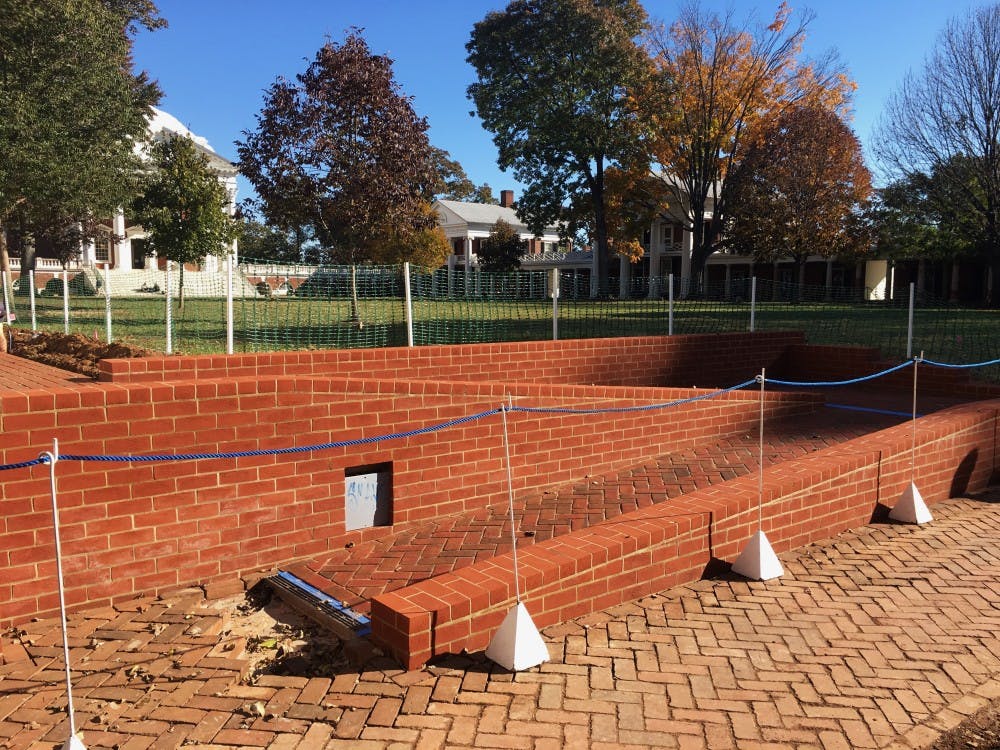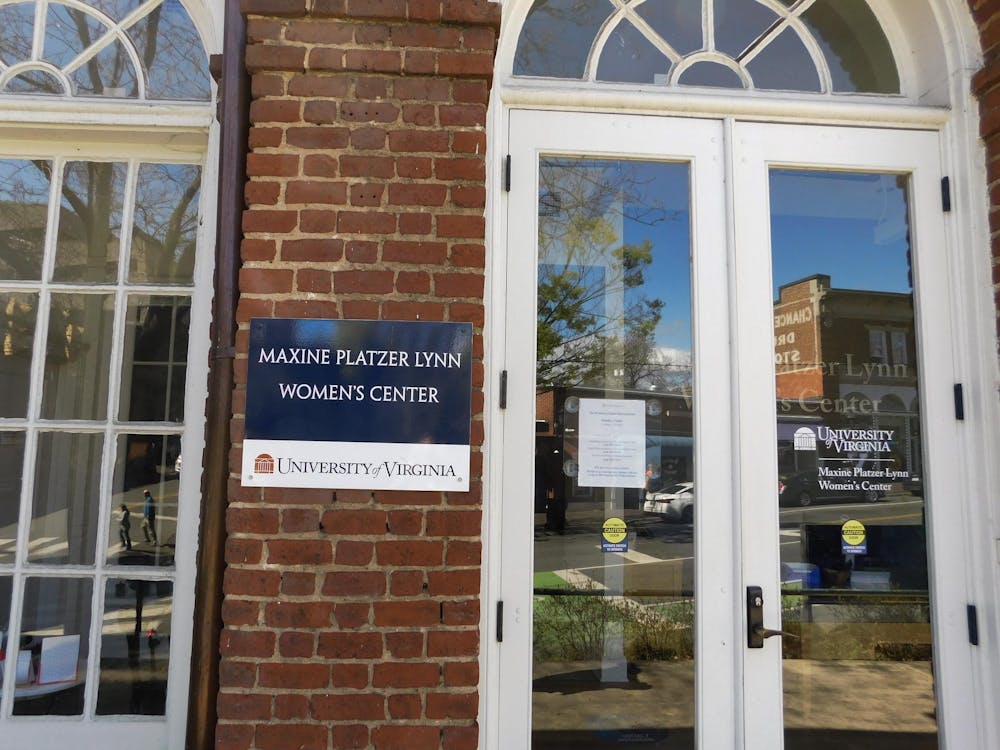The construction of two permanent, wheelchair-accessible ramps on the western side of the Lawn will be completed by the start of the spring semester, according to U.Va. officials. The ramps — part of the Lawn Accessibility Project — will provide a continuous and obstruction-free path from the Rotunda to Old Cabell Hall for students and visitors with mobility impairments.
The project will cost approximately $974,000, according to James Zehmer, a historic preservation project manager in the Office of Facilities Planning and Construction.
Shea Megale, a second-year College student who uses a motorized wheelchair, said she has not yet experienced events like Rotunda Sing, Lighting of the Lawn or Trick or Treating on the Lawn.
“I haven't gone to any of that and I'd really like to be more a part of the Lawn,” Megale said. “It's the central place of U.Va.”
There are nearly 200 students at the University like Megale, with mobility disabilities registered through the Student Disability Access Center. This number does not account for those who do not disclose their physical impairments and the segment of the University’s 200,000 annual visitors with mobility disabilities.
The Lawn — the center of Grounds for many visitors and members of the University community — has been compliant with the Americans with Disabilities Act since the 1990s. However, prior to the construction of the ramps, those who could not navigate the hills by Pavilions V and IX were required to leave and reenter through the McCormick Road alleyways in order to maneuver each incline, which made the Lawn uninviting for individuals with disabilities.
Megale, who has traveled around the world, says she was surprised by the slopes of the Lawn on her first tour of U.Va., especially after asking her tour guide if it was accessible.
"He answered ‘Well, there are a couple hills,’ and I thought to myself, ‘I can do a couple hills — I've done the outback of Australia and the rainforests of El Yunque,’” she said.
But the inclines of the Lawn proved to be steeper and more dangerous than she was led to believe.
“I was terrified,” Megale said. “I went down backwards. Once I did one, I didn’t realize I was stuck doing three others … After that experience, I thought, ‘Is U.Va. the right place?’”
Cory Paradis, a 2018 School of Architecture alumnus and wheelchair user, has attended events on the Lawn, but typically avoided the area due its inaccessibility, resulting in an inability to experience a large part of the University.
“I've gone to Lighting of the Lawn several times, and I've had to have people lift me up and down the steps,” Paradis said. “It definitely limits your social opportunities because a lot of parties and stuff happen on the Lawn … I avoid that area because it's so much of a pain to navigate.”
As a current member of the Barrier-Free Access Committee and teaching assistant in the School of Architecture, Paradis has made it his mission to educate others about accessibility.
“The only way for people to really understand the issue is to either learn from somebody or go through something themselves,” he said. “I’m an asset for … the students … [and] I can share my experiences.”
Paradis says he impresses the necessity of accessibility in design on his architecture students.
“If people aren't aware, they have no clue that there is even a problem,” Paradis said. “I want to get them in the mindset from the beginning that accessibility needs to be one of the top priorities whenever you design anything.”
In 2015, Paradis first met with Wynne Stuart, the associate provost for academic support and classroom management and chair of the Barrier-Free Access Committee — a University committee that makes recommendations for making the institution better for individuals with disabilities — to discuss accessibility around the University.
Stuart worked on installing ramps for 10 years as the chair of the Barrier-Free Access Committee. The process to adapt the Lawn to better accommodate students and visitors with ambulatory disabilities began two years ago, with the arrival of University Architect Alice Raucher.
Stuart said Raucher immediately embraced the idea. According to Stuart, Raucher and Colette Sheehy — the University’s senior vice president for operations — were instrumental in bringing the project to completion.
Stuart explained that architecture projects at the University are dependent on the respective architect of the University and said that Raucher’s predecessor, David J. Neuman, focused on bigger picture projects.
“The previous architect for the University had many other things to do and was trying to figure out the whole land plan of the University, so he focused less on specifics,” Stuart said.
Due to its historic prestige, the Lawn has been one of the most difficult projects Stuart has proposed.
“There was some concern that it was going to change the character of the Lawn,” Stuart said. “As you look out, [was this] really what Jefferson meant? Did we want to alter this?”
In response to the critics who voiced concerns about ramps being an eyesore, Stuart responds said the claim is historically hypocritical.
“First, the construction of Cocke, Rouss and Old Cabell Halls in the 19th century closed Jefferson’s intended view of the mountains, so we have a big precedent there,” Stuart said. “Second, we have to keep up with the world. The time had come, and although we were legally compliant, it was not inclusive, and we were seeking to be more inclusive.”
Stuart was motivated to complete this project when a student with a motorized wheelchair debated living on the Lawn.
“At that point, I did thoroughly understand that if you lived on the Lawn, you could only get out of your room and visit those on your level — but if we have these ramps, virtually all the rooms are accessible,” Stuart said.
Stuart said that the University is striving to go beyond compliance with the Americans with Disabilities Act to create an environment on the Lawn where all students feel welcomed.
“What we have been working towards on the Lawn is not just the letter of the law, which we met, but the spirit of inclusion,” Stuart said.
Despite her first impression, Megale said she appreciates the effort the University has put forward to achieve inclusivity, in contrast to other universities.
“Even though there is work to do, U.Va. is several steps ahead of other state schools,” she said.
“In my tours of other schools … [there were] entire academic buildings that were not accessible.”
Paradis said he recognizes the challenges associated with working with a historic site.
“People want the Lawn to be as it was in Jefferson's time, but Jefferson was an innovator, and if he was alive today, he would say, ‘This is crazy — we need to change the way we think about this,’” Paradis said. “Since it is a UNESCO World Heritage Site, you want it to be as realistic as it was in the 1800s, but at what point do you put the present need above past experiences?”






